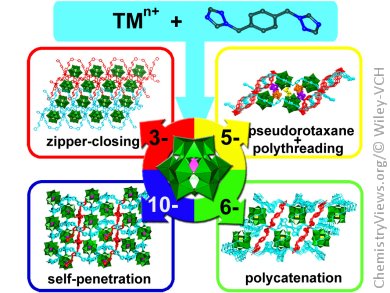The combination of polyoxometalates (POMs) and metal-organic coordination networks leads to new hybrid systems in which the merits of both components converge.
Yang-Guang Li and Yong-Hui Wang, Northeast Normal University, China, Fu-Chen Liu, Tianjin University of Technology, China, and their colleagues have prepared four such hybrid compounds based on transition-metal ions, 1,4-bis(1,2,4-triazol-1-ylmethyl)benzene ligand, and charge-tunable Keggin-type POMs. The chemically charge-tunable Keggin-type POMs play the key role in modulating the final structural topology and photocatalytic activity. An increase in the negative charge of the POM unit results in an increase in the node number and dimensionality of the basic metal–organic building blocks in these compounds. Furthermore, new entangled structural topologies are observed, such as a 2D polypseudorotaxane network, a 3D polythreading framework, and a (3,6)-connected 3D self-penetrating framework.
This work highlights the important role of POMs in the construction of hybrid compounds and may provide an interesting strategy to prepare function-directed hybrid compounds based on POMs.
- New Entangled Coordination Networks Based on Charge-Tunable Keggin-Type Polyoxometalates,
Xiu-Li Hao, Yuan-Yuan Ma, Yong-Hui Wang, Long-Yang Xu, Fu-Chen Liu, Mao-Mao Zhang, Yang-Guang Li,
Chem Asian J. 2014.
DOI: 10.1002/asia.201301378



